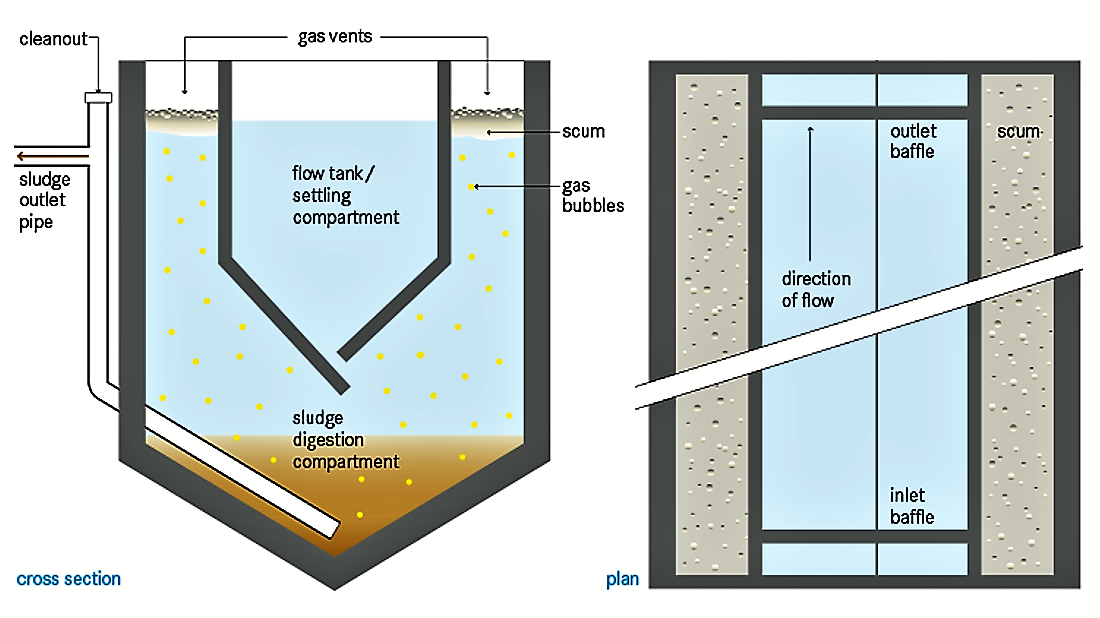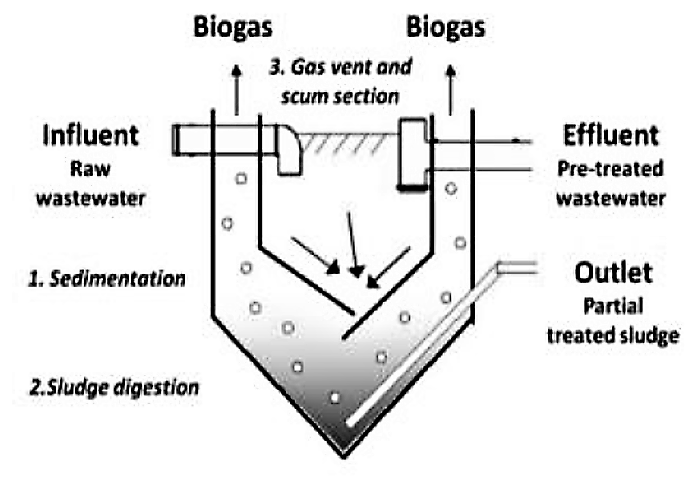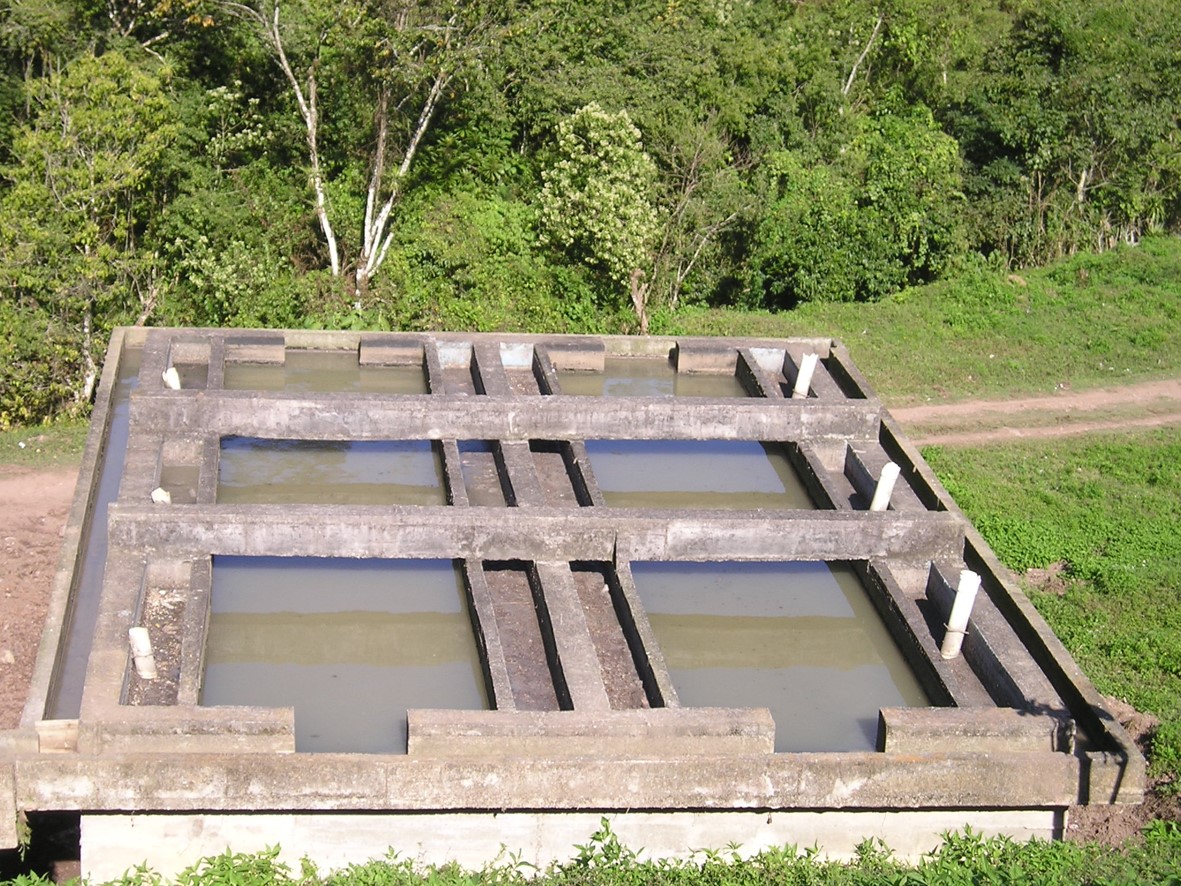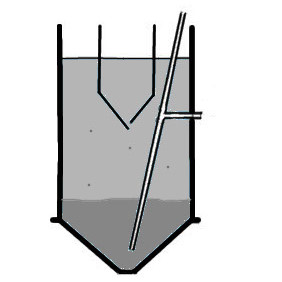Executive Summary
The Imhoff tank is a primary treatment technology for raw wastewater, designed for solid-liquid separation and digestion of the settled sludge. It consists of a V-shaped settling compartment above a tapering sludge digestion chamber with gas vents. In the digestsion chamber, the settled solids are anaerobically digested generating biogas. The gas is deflected by baffles to the gas vent channels to prevent it from disturbing the settling process. Imhoff tanks are used by small communities and due to the underground construction, land use is very limited. Investment costs are low and operation and maintenance simple. But the treatment efficiency is low and a secondary treatment of the effluent is required. Moreover, the tanks must be desludged regularly.
| In | Out |
|---|---|
Blackwater (settled), Faecal Sludge, (Biogas) |
Introduction
The Imhoff tank (also known as Emscherbrunnen or Emscher Tank), which works similar to a communal septic tank, is a robust and effective settler that causes a suspended solids reduction of 50 to 70%, COD reduction of 25 to 50%, and leads to potentially good sludge stabilisation – depending on the design and conditions. It is a compact and efficient system for pre-treatment of municipal wastewater.
The settling compartment has a circular or rectangular shape with V-shaped walls and a slot at the bottom, allowing solids to settle into the digestion compartment, while preventing foul gas from rising up and disturbing the settling process. Gas produced in the digestion chamber rises into the gas vents at the edge of the reactor. It transports sludge particles to the water surface, creating a scum layer. The sludge accumulates in the sludge digestion chamber, and is compacted and partially stabilised through anaerobic digestion. The liquid fraction remains only some hours in the tank, while the solids remain for several years in the digestion chamber.
There is more biogas production than in septic tanks, but unfortunately the organic load in communal wastewater is usually not high enough for the economical collection and usage (or flaring) of biogas (HOFFMANN et al. 2011). The pre-treated wastewater from the Imhoff tank requires a secondary treatment (e.g. leach field, soak pits, horizontal flow, vertical flow or free-surface constructed wetlands).
Also the faecal sludge needs to be correctly disposed and further treated (e.g. small or large scale composting, settling - thickening ponds or drying beds). If the sludge is composted either directly or after drying, it can be used as fertiliser to improve the soil quality (see also use of compost or fertiliser from sludge).

Design Considerations
The Imhoff tank is designed with three compartments (see picture below):
- Upper compartment for sedimentation
- Lower section for sludge digestion
- Gas vent and scum section

Scum and gas vent chambers are located at the sides of the tank. It can be an open or covered tank (WSP 2007). A covered tank avoids infiltration of precipitation and pollutants. However, it is always preferred to cover the tank to prevent contact with people and animals (see also water sanitation and health or health risk management). An outlet for desludging can be added.
The Imhoff tank is usually built underground with reinforced concrete. It can, however, also be built above ground, which makes sludge removal easier due to gravity, although still requiring pumping up of the influent. Small prefabricated Imhoff tanks are also available on the market. Hydraulic retention time is usually not more than 2 to 4 h to preserve an aerobic effluent for further treatment or discharge (find other treatment technologies here and also under http://ecompendium.sswm.info/sanitation-technologies). T-shaped pipes or baffles are used at the inlet and the outlet to reduce velocity and prevent scum from leaving the system.
The total water depth in the tank from the bottom to the water surface may reach 7 to 9.5 m. The bottom of the settling compartment is typically sloped 1.25 to 1.75 vertical to 1 horizontal and the slot opening can be 150 to 300 mm wide. The walls of the sludge digestion compartment should have an inclination of 45° or more. This allows the sludge to slide down to the centre where it can be removed. Dimensioning of the anaerobic digestion compartment depends mainly on sludge production per population equivalent, on the targeted degree of sludge stabilisation (linked to the desludging frequency) and the temperature. The digestion chamber is usually designed for 4 to 12 months sludge storage capacity to allow for sufficient anaerobic digestion.
In colder climates longer sludge retention time and, therefore, a greater volume is needed. For desludging, a pipe and pump have to be installed or access provided for vacuum trucks and mobile pumps (see also motorised emptying and transport). A bar screen or grit chamber (see pre-treatment technologies) is recommended before the Imhoff tank to prevent coarse material from disturbing the system.

Health Aspects/Acceptance
As the effluent is almost odourless, it is a good option for primary treatment if subsequent treatment takes place, e.g., in open ponds, constructed wetlands (see also vertical flow constructed wetland, horizontal flow constructed wetland or free-water surface constructed wetland) or trickling filters. Greenhouse gases produced in low quantities may, however, generate odours locally. Pathogen removal is low and all outputs should be treated before they are used e.g. for irrigation or as fertiliser. Although the removal of pathogens is not high, the entire tank is usually below the surface so users do not come in contact with any of the wastewater . Adequate protective clothing is necessary for workers who may get in contact with the effluent, scum or sludge. A vacuum truck should be used to empty the sludge, if there is no pumped outlet installed. Users should not attempt to empty the pit themselves except with a manual technology like the gulper (see also motorised emptying and human-powered emptying). Users should be careful when opening the tank because noxious and flammable gases may be released.

Costs Considerations
Construction costs are slightly higher than the costs for a septic tank (SANIMAS 2005). Also the costs for desludging (motorised or manual) must be considered. Moreover, it is a pre-treatment facility and in many cases connected to further treatment installations (e.g. leach field, soak pits, horizontal flow, vertical flow or free-surface constructed wetlands).
Operation & Maintenance
Operation and maintenance (click here for further information on operation and maintenance) are possible at low cost, if trained personnel are in charge. Flow paths have to be kept open and cleaned out weekly, while scum in the settling compartment and the gas vents has to be removed daily if necessary. Regular cleaning of the sides of the settling chamber and slot by rake or squeegee is very important. Another activity, which should be done twice a month is to reversing the flow (backwash) of water to even up the solids in the digestion chamber (WSP 2007; SANIMAS 2005; SASSE 1998). Stabilised sludge from the bottom of the digestion compartment should be removed according to the design. The sludge can be removed by pumping or hydraulic pressure pipes right from the bottom or by a vacuum truck (see also motorised emptying). A minimum clearance of 50 cm between the sludge blanket and the slot of the settling chamber has to be ensured at all times.
At a Glance
| Working Principle | Settling of solids occurs in the upper compartment. Sludge falls through the slot to the bottom of the settling compartment into the lower tank, where it is digested. |
| Capacity/Adequacy | Imhoff tanks ar e used by small communities for primary treatment of grey- and blackwater. |
| Performance | Removes 25 to 50% of COD. Pathogen removal is low. |
| Costs | Construction costs are slightly higher than the costs of a septic tank. |
| Self-help Compatibility | Requires expert design, but can be constructed with locally available material. |
| O&M | Should be checked for water tightness, scum and sludge levels regularly. Sludge needs to be dug out every 1 to 5 years and discharged properly (e.g. in composting or drying bed). Needs to be vented. |
| Reliability | Reliable if amply designed and desludging carried out routinely. Imhoff tanks are resistant against shock loads. |
| Main strength | Simple to construct and to operate. |
| Main weakness |
Imhoff tanks are recommended for domestic or mixed wastewater flows between 50 and 20,000 population equivalents. They are able to treat high organic loads and are resistant against organic shock loads. Space requirements are low. Normally, Imhoff tanks are used by small communities with raw wastewater flows on the order of 950 m3/day (population about 8000 people or 1300 households) (WSP 2007).
Imhoff tanks can be used in warm and cold climates (wastewater temperatures below 15°C or above 2000 m altitude; minimum winter temperature is 8°C, average for the year is 20°C) (HOFFMANN et al. 2011) . As the tank is very high, it can be built underground if the groundwater table is low and the location is not flood prone. If constructed underground, land use is very limited and Imhoff tanks can be constructed in both, rural or urban areas. Investment costs are low and operation and maintenance simple.
Filières d'Epuration Adaptées aux Petites Collectivités
The aim of this document is to help to identify the best technology options for small communities depending on the situation at hand.
ALEXANDRE, O. BOUTIN, C. DUCHENE, PH. LAGRANGE, C. LAKEL, A. LIENARD, A. ORDITZ, D. (1998): Filières d'Epuration Adaptées aux Petites Collectivités . (= Document technique FNDAE , 22 ). Lyon: Centre National du Machinisme Agricole, du Genie Rural, des Eaux et des Forets (CEMAGREF) URL [Accessed: 08.10.2013]Rehabilitation of the Imhoff Tank Treatment Plant in Las Vegas, Santa Barbara Honduras, Central America
This case study provides general information about Imhoff tanks and insights into implementation and operational problems. Recommendations for operation and maintenance are provided.
HERRERA, A. (2006): Rehabilitation of the Imhoff Tank Treatment Plant in Las Vegas, Santa Barbara Honduras, Central America. Master thesis. Austin: Department of Civil, Architectural and Environmental Engineering, University of TexasTechnology Review of Constructed Wetlands
This publication intends to help spread awareness and knowledge about the technology of subsurface flow constructed wetlands in developing countries. Constructed wetlands (CWs) can be used as part of decentralised wastewater treatment systems, due to their “robust”, “low-tech” nature with none or few moving parts (pumps) and relatively low operational requirements. CWs can be used for the treatment of domestic and municipal wastewater or greywater, and play an important role in many ecological sanitation (ecosan) concepts.
HOFFMANN, H. PLATZER, C. WINKER, M. MUENCH, E. von GIZ (2011): Technology Review of Constructed Wetlands. Subsurface Flow Constructed Wetlands for Greywater and Domestic Wastewater Treatment. Eschborn: Deutsche Gesellschaft fuer Internationale Zusammenarbeit (GIZ) GmbH URL [Accessed: 01.06.2019]Honduras Wastewater Treatment: Chemically Enhanced Primary Treatment and Sustainable Secondary Treatment Technologies for Use with Imhoff Tanks
This work seeks to expand upon the body of knowledge pertinent to enhance the treatment efficacy of Imhoff tanks within Honduras. It also includes a definition for what an Imhoff tank is and explanation of how the system works.
McLEAN, R.C. (2008): Honduras Wastewater Treatment: Chemically Enhanced Primary Treatment and Sustainable Secondary Treatment Technologies for Use with Imhoff Tanks. Pomona: California State Polytechnic University URL [Accessed: 01.06.2019]A Proposal to Implement a Circuit Rider Program in Honduras
The long-term vision of this project is to provide on-site technical assistance to Honduran communities who currently possess wastewater treatment infrastructure. It aims to mobilise the technical knowledge in order to rehabilitate and optimise existing systems.
MIKELONIS, A. (2008): A Proposal to Implement a Circuit Rider Program in Honduras. Cambridge: Massachusetts Institute of Technology (MIT) URL [Accessed: 09.02.2011]Informed Choice Catalogue
This informed choice catalogue for community based wastewater treatment technologies helps to identify suitable sanitation options and facilitates the assessment of different sanitation system components with regard to stakeholder preferences. A powerful tool for technical bottom-up planning giving overall information about technical options at a "glance".
SANIMAS (2005): Informed Choice Catalogue. pdf presentation. BORDA and USAID URL [Accessed: 29.05.2019]DEWATS
Exhaustive report on technological, operational and economic aspects of decentralised waste water treatment systems. Spreadsheet examples support the reader in designing and planning waste water treatment systems components.
SASSE, L. BORDA (1998): DEWATS. Decentralised Wastewater Treatment in Developing Countries. Bremen: Bremen Overseas Research and Development Association (BORDA) URL [Accessed: 03.06.2019]Philippines Sanitation Source Book and Decision Aid
This Sanitation Sourcebook distils some of the core concepts of sanitation in a user-friendly format so that the book can serve as a practical reference to sanitation professionals and investment decision-makers, particularly the local governments. The annexe contains a practical collection of factsheets on selected sanitation system options.
WSP (2007): Philippines Sanitation Source Book and Decision Aid. pdf presentation. Washington: Water and Sanitation Program (WSP). URL [Accessed: 01.06.2019]Compendium of Sanitation Systems and Technologies. 2nd Revised Edition
This compendium gives a systematic overview on different sanitation systems and technologies and describes a wide range of available low-cost sanitation technologies.
TILLEY, E., ULRICH L., LÜTHI, C., REYMOND P. and ZURBRÜGG C. (2014): Compendium of Sanitation Systems and Technologies. 2nd Revised Edition. Duebendorf, Switzerland: Swiss Federal Institute of Aquatic Science and Technology (Eawag) URL [Accessed: 03.05.2023] PDFCompendium of Sanitation Systems and Technologies (Arabic)
This is the Arabic version of the Compendium of Sanitation Systems and Technologies. The Compendium gives a systematic overview on different sanitation systems and technologies and describes a wide range of available low-cost sanitation technologies.
TILLEY, E. ULRICH, L. LUETHI, C. REYMOND, P. SCHERTENLEIB, R. ZURBRUEGG, C. (2014): Compendium of Sanitation Systems and Technologies (Arabic). 2nd Revised Edition. Duebendorf, Switzerland: Swiss Federal Institute of Aquatic Science and Technology (Eawag) PDFTechnology Review of Constructed Wetlands
This publication intends to help spread awareness and knowledge about the technology of subsurface flow constructed wetlands in developing countries. Constructed wetlands (CWs) can be used as part of decentralised wastewater treatment systems, due to their “robust”, “low-tech” nature with none or few moving parts (pumps) and relatively low operational requirements. CWs can be used for the treatment of domestic and municipal wastewater or greywater, and play an important role in many ecological sanitation (ecosan) concepts.
HOFFMANN, H. PLATZER, C. WINKER, M. MUENCH, E. von GIZ (2011): Technology Review of Constructed Wetlands. Subsurface Flow Constructed Wetlands for Greywater and Domestic Wastewater Treatment. Eschborn: Deutsche Gesellschaft fuer Internationale Zusammenarbeit (GIZ) GmbH URL [Accessed: 01.06.2019]How to Select Appropriate Technical Solutions for Sanitation
The purpose of this guide is to assist local contracting authorities and their partners in identifying those sanitation technologies best suited to the different contexts that exist within their town. The first part of the guide contains a planning process and a set of criteria to be completed; these assist you in characterizing each area of intervention so that you are then in a position to identify the most appropriate technical solutions. The second part of the guide consists of technical factsheets which give a practical overview of the technical and economic characteristics, the operating principle and the pros and cons of the 29 sanitation technology options most commonly used in sub-Saharan Africa.
MONVOIS, J. GABERT, J. FRENOUX, C. GUILLAUME, M. (2010): How to Select Appropriate Technical Solutions for Sanitation. (= Six Methodological Guides for a Water and Sanitation Services' Development Strategy , 4 ). Cotonou and Paris: Partenariat pour le Développement Municipal (PDM) and Programme Solidarité Eau (pS-Eau) URL [Accessed: 19.10.2011]Informed Choice Catalogue
This informed choice catalogue for community based wastewater treatment technologies helps to identify suitable sanitation options and facilitates the assessment of different sanitation system components with regard to stakeholder preferences. A powerful tool for technical bottom-up planning giving overall information about technical options at a "glance".
SANIMAS (2005): Informed Choice Catalogue. pdf presentation. BORDA and USAID URL [Accessed: 29.05.2019]DEWATS
Exhaustive report on technological, operational and economic aspects of decentralised waste water treatment systems. Spreadsheet examples support the reader in designing and planning waste water treatment systems components.
SASSE, L. BORDA (1998): DEWATS. Decentralised Wastewater Treatment in Developing Countries. Bremen: Bremen Overseas Research and Development Association (BORDA) URL [Accessed: 03.06.2019]A Directory of Environmentally Sound Technologies for the Integrated Management of Solid, Liquid and Hazardous Waste for Small Island Developing States (SIDS) in the Pacific Region
This directory is part of UNEP collaboration with SIDS on the implementation of the Waste Management chapter of the Barbados Programme of Action. It focuses primarily on proven sound environmental technologies for solid, liquid and hazardous waste management plus those currently successfully being used in SIDS within the Pacific Region.
UNEP (2002): A Directory of Environmentally Sound Technologies for the Integrated Management of Solid, Liquid and Hazardous Waste for Small Island Developing States (SIDS) in the Pacific Region. The Hague: United Nations Environment Programme (UNEP) URL [Accessed: 28.03.2012]A Guide to the Development of On-site Sanitation
The publication presents appropriate technologies for sanitation and highlights socio-economic aspects of planning and implementing. Emphasis is given to household-level sanitation improvements for urban areas, as well as rural areas and small communities. Background information on sanitation, in-depth technical information on the design, construction, operation and maintenance and project planning and development processes involved in projects and programmes complement the book.
WHO (1992): A Guide to the Development of On-site Sanitation. Geneva: World Health Organisation (WHO) URL [Accessed: 14.04.2010]Philippines Sanitation Source Book and Decision Aid
This Sanitation Sourcebook distils some of the core concepts of sanitation in a user-friendly format so that the book can serve as a practical reference to sanitation professionals and investment decision-makers, particularly the local governments. The annexe contains a practical collection of factsheets on selected sanitation system options.
WSP (2007): Philippines Sanitation Source Book and Decision Aid. pdf presentation. Washington: Water and Sanitation Program (WSP). URL [Accessed: 01.06.2019]Honduras Wastewater Treatment: Chemically Enhanced Primary Treatment and Sustainable Secondary Treatment Technologies for Use with Imhoff Tanks
This work seeks to expand upon the body of knowledge pertinent to enhance the treatment efficacy of Imhoff tanks within Honduras. It also includes a definition for what an Imhoff tank is and explanation of how the system works.
McLEAN, R.C. (2008): Honduras Wastewater Treatment: Chemically Enhanced Primary Treatment and Sustainable Secondary Treatment Technologies for Use with Imhoff Tanks. Pomona: California State Polytechnic University URL [Accessed: 01.06.2019]A Proposal to Implement a Circuit Rider Program in Honduras
The long-term vision of this project is to provide on-site technical assistance to Honduran communities who currently possess wastewater treatment infrastructure. It aims to mobilise the technical knowledge in order to rehabilitate and optimise existing systems.
MIKELONIS, A. (2008): A Proposal to Implement a Circuit Rider Program in Honduras. Cambridge: Massachusetts Institute of Technology (MIT) URL [Accessed: 09.02.2011]Ecological Settlement in Allermoehe Hamburg, Germany
This case study is about a full-scale residential settlement project in an urban area in Hamburg, Germany. The settlement was built between 1982 and 1994 and consists of 36 single-family houses with approx. 140 inhabitants. The project aims at having an ecological closed-loop process via on-site wastewater treatment and therefore independence from a sewage system. Rainwater harvesting, composting toilets and constructed wetlands were the technologies applied in the project. Thereby a high resource and energy efficiency can be achieved.
RAUSCHNING, G. BERGER, W. EBELING, B. SCHOEPE, A. (2009): Ecological Settlement in Allermoehe Hamburg, Germany. Eschborn: Sustainable Sanitation Alliance (SuSanA) URL [Accessed: 24.09.2013]http://www.boerdepurazioni.com/
This website contains a short description and a drawing of the Imhoff tank.

